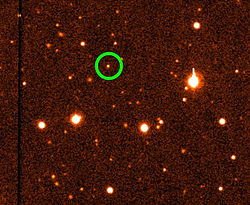Orcus (dwarf planet)
 | |
| Discovery | |
|---|---|
| Discovered by | M. Brown, C. Trujillo, D. Rabinowitz |
| Discovery date | February 17, 2004 |
| Designations | |
| 2004 DW | |
| Plutino | |
| Orbital characteristics | |
| Epoch November 10, 1951 (JD 2433960.5) | |
| Aphelion | 7226.801 Gm (48.31 AU) |
| Perihelion | 4567.091 Gm (30.53 AU) |
| 5896.946 Gm (39.419 AU) | |
| Eccentricity | 0.22552 |
| 90396.4 d (247.492 a) | |
Average orbital speed | 4.68 km/s |
| 79.561° | |
| Inclination | 20.55233° |
| 268.586° | |
| 73.8325° | |
| Known satellites | 1 (92-432 km) |
| Physical characteristics | |
| Dimensions | 946.3+74.1-72.3 km[1] |
| Mass | ~7.5×1020 kg |
Mean density | ~1.5 g/cm³ (assumed) |
| ~0.2 m/s² | |
| ~0.44 km/s | |
| ? d | |
| Albedo | 19.75+3.40-2.76 % |
| Temperature | ~45 K |
Spectral type | B-V=0.68; V-R=0.37 [2] |
| 19.11 | |
| 2.3 | |
90482 Orcus (/ˈɔrkəs/ or'-kəs, Latin: Orcus, originally known by the provisional designation 2004 DW) is a Kuiper Belt object (KBO) that was discovered by Michael Brown of Caltech, Chad Trujillo of the Gemini Observatory, and David Rabinowitz of Yale University. The discovery images of this object were acquired on February 17, 2004. Precovery images as early as November 8, 1951 were later identified.
Orbit

Orcus is a typical plutino (an object in 2:3 orbital resonance with Neptune). Orcus's 247 year orbit is shaped similarly to Pluto's (both have perihelia above the ecliptic), but is differently oriented. Although at one point its orbit approaches that of Neptune, the resonance between the two bodies means that Orcus itself is always a great distance away from Neptune (there is always an angular separation of over 60 degrees between them).
Physical characteristics
Size and magnitude
Error: Image is invalid or non-existent.
The absolute magnitude of Orcus is 2.3 (comparable with the 2.6 of another KBO, 50000 Quaoar). In the first quarter of 2007 a paper was published, showing the Spitzer space telescope had detected Orcus in the far infrared, during its first three years in operation, constraining the size to 946.3+74.1-72.3 km.[1]. Orcus appears to have a high albedo of ~ 20 %.
Colours and spectra
Observations in infrared by the European Southern Observatory give results consistent with mixtures of water ice and carbonaceous compounds.[3] Further, the infrared spectra taken with the Gemini telescope confirmed a modest water ice signature, compatible with a cover of 15–30%, but no more than 50% of the surface. This means there is less ice than on Charon, but a similar amount to that on Triton. Limitations were also placed on the amount of methane ice (less than 30%) leaving open the possibility for discovery of other components in the future.[4]
KBOs display a diversity of colours and spectra even among objects with similar orbits. Orcus presents a neutral colour in comparison with the redness of an object like Ixion.
Satellite
The discovery of a satellite of Orcus was reported in IAUC 8812 on 22 February 2007 [1]. The orbit of this satellite has yet to be determined.
The satellite was found at 0.25 arcsec from Orcus with magnitude difference of 2.7[5]. Assuming an albedo similar to that of the primary the magnitude suggests a quite substantial diameter (~220 km) compared with Orcus.
Name
Under the guidelines of the International Astronomical Union's naming conventions, objects with a similar size and orbit to that of Pluto are named after underworld deities. Accordingly, the discoverers suggested naming the object after Orcus, a god of the dead in Roman mythology. The name was approved and published on November 22, 2004.
External links and sources
- MPEC 2004-D09 announcing the discovery but attributing it to Raymond J. Bambery, Steven H. Pravdo, Michael D. Hicks, Kenneth J. Lawrence, Daniel MacDonald, Eleanor F. Helin and Robert Thicksten / NEAT
- MPEC 2004-D13 correcting MPEC 2004-D09
- Chad Trujillo's page on 2004 DW
- First BBC article
- First New Scientist article
- Updated orbital elements from Lowell Observatory
- AstDys orbital elements
- Orbital simulation from JPL (Java) / Ephemeris
References
- ^ a b Stansberry, J. (2007). "Physical Properties of Kuiper Belt and Centaur Objects: Constraints from Spitzer Space Telescope".
{{cite journal}}: Cite journal requires|journal=(help); Unknown parameter|coauthors=ignored (|author=suggested) (help) - ^ Tegler, Stephen C. (2006-01-26). "Kuiper Belt Object Magnitudes and Surface Colors". Retrieved 2006-11-05.
{{cite web}}: Cite has empty unknown parameter:|coauthors=(help) - ^ C. de Bergh, A. Delsanti, G. P. Tozzi, E. Dotto, A. Doressoundiram and M. A. Barucci (2005). "The Surface of the Transneptunian Object 9048 Orcus". Astronomy & Astrophysics. 437: 1115–1120. doi:10.1051/0004-6361:20042533.
{{cite journal}}: CS1 maint: multiple names: authors list (link) - ^ Chadwick A. Trujillo, Michael E. Brown, David L. Rabinowitz, Thomas R. Geballe (2005). "Near Infrared Surface Properties of the Two Intrinsically Brightest Minor Planets (90377) Sedna and (90482) Orcus". The Astrophysical Journal. 627: 1057–1065. doi:10.1086/430337.
{{cite journal}}: CS1 maint: multiple names: authors list (link) Preprint on arXiv. - ^ Distant EKO The Kuiper Belt Electronic newsletter, March 2007
